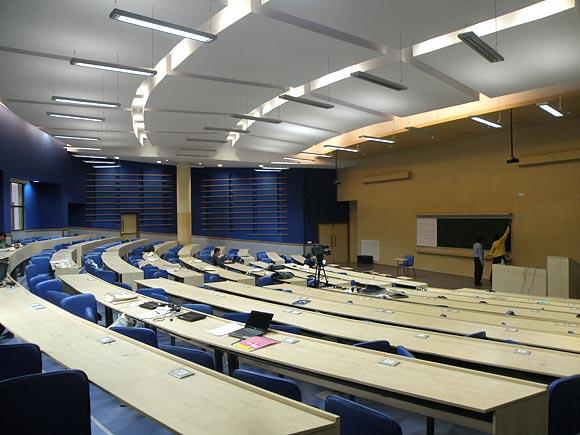
While Indian universities stagnate, those in China are becoming engines of growth.
In the latest annual rankings of the world's 200 best universities, by Times Higher Education (THE) there's not a single Indian name.
Shocking? Then here's the surprise: 15 Asian universities figure in the same survey as the rising stars of global higher education -- two from China, three from South Korea, four from Japan, four from Hong Kong, one from Singapore, and one from Taiwan.
Put the two facts together, and you get a pretty good idea of what the new class is going to be like.
Japan, of course, has been for long a respected presence on the global academic scene and will continue to be a steady winner in future rankings.
But it's China (including Hong Kong and Taiwan), South Korea and Singapore that are making waves right now -- in particular, China and South Korea -- as they entrench their positions as the world's new destinations of excellence, Western domination of global higher education, still unquestioned, could begin to feel the pinch.
In the THE rankings, universities are judged for teaching quality, research activities, knowledge transfer, and international outlook.
If, against these criteria, the National University of Singapore could occupy the 29th position in the 2012-13 survey, the University of Hong Kong the 35th, Peking and Tsinghua Universities in China the 46th and 52nd places, respectively, Seoul National University the 59th slot and Korea Advanced Institute of Science and Technology the 68th, the future shouldn't be hard to read.
Even more remarkable is the strength of the determination to excel.
The National University of Singapore, for example, moved up 11 notches from a year ago, while Tsinghua and Seoul National jumped 19 and 56 places, respectively, in a single year. Academic circles in the West believe a bigger Asian presence in the global league is only a matter of time.
Where exactly does India stand? A year ago, India was nowhere even among the world's 300 best, and the Indian Institute of Technology, Mumbai had a presence in the 301-350 band.
In 2012-13, IIT Kharagpur appeared in the 226-250 bracket, IIT Mumbai advanced into the 251-275 range, while IIT Roorkee sneaked into the last of the ranking categories, 351-400.
There's a movement, yes, but still a very tentative one.
Please click NEXT to continue reading...

What's the secret that the Chinese and the Koreans know and we don't?
Simply put, it's their desire to blend pure academic pursuits with down-to-earth R&D, go the extra mile to woo international talent, open up channels of international cooperation, and turn universities into laboratories of national development.
Working towards this end, and encouraged by their governments, universities in the two countries have undergone a character change that foreign students and professors find increasingly hospitable, as do foreign corporations looking across borders for partnerships in problem-solving research.
Both countries have been pumping huge amounts of money every year into research and higher education.
South Korea, where the private sector accounts for almost 74 per cent of all R&D spending, has a funding programme called the "World-Class University Project" that encourages universities to establish new academic departments and host international scholars for collaborative research.
China treats its universities and research institutes as "engines of growth", expecting them to function as idea machines to serve specific industry needs.
It's not a surprise therefore that foreign professors and students are as welcome in China as multinational corporations seeking to expand R&D alliances in the country.
IBM, Intel, Microsoft, and many other foreign firms have substantial collaborative arrangements with Chinese universities. China's own R&D spending, coursed mainly through its universities and research institutes, was up 23 per cent to $139.2 billion in 2011, which meant a steady rise of 20 per cent on average for the sixth straight year.
Until as late as 1993, exchanging students, swapping information, and attending international conferences were the primary modes of China's international academic collaboration.
Things began to change when a new law was introduced that year on the future of science and technology in the country. Beijing's Tsinghua University -- where this year's Nobel Prize co-winner in Chemistry, Brian Kobilka, is a guest professor -- reflects how this change is affecting Chinese academia.
In 1950, Tsinghua only had 14 foreign students on its rolls, all from Eastern Europe. In October last year, 3,450 international students from 112 countries were studying there.
In recent years, it has been particularly aggressive in seeking R&D collaborations with international partners, widening the scope it offers for practical research and enhancing its appeal among students and teachers alike.
A typical example is a new lab that BT, a leading provider of communications services, is setting up at Tsinghua to undertake joint projects in areas like the business application of cloud computing.
The purpose is as much to provide a bridge between Chinese innovation and BT technology as to develop new global patents that will give both China and BT a better competitive advantage.